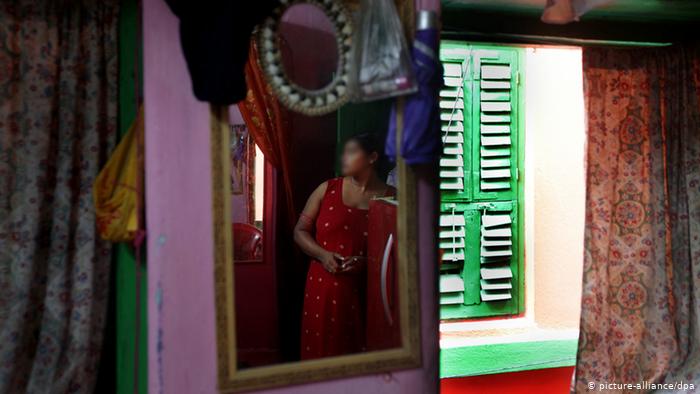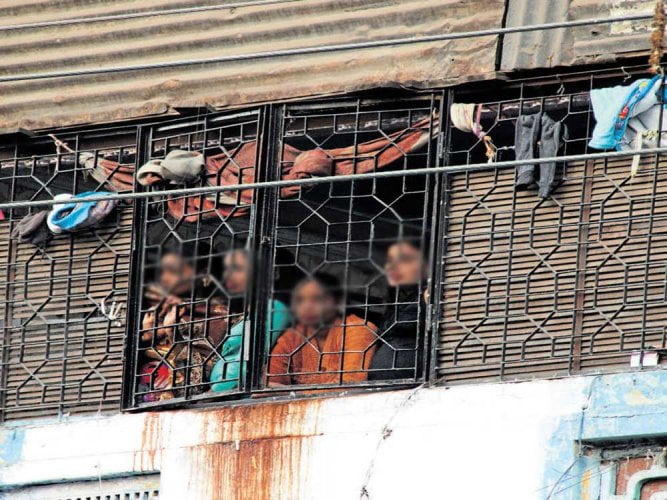Posted by Sanhati Banerjee
North Kolkata’s Sonagachi is home to labyrinthine lanes populated by several multi-storied columns of buildings and sex workers living in shared rooms—with as many as 10 sharing a room. The oldest and largest red-light district of Asia currently houses around 5,000 brothel-based sex workers, many with children (excluding another 3,000-4,000 who commute daily), from the suburbs, parts of rural Bengal and the neighbouring states of Bihar, Jharkhand and Odisha. On a regular day, the brothels used to receive 10,000-15,000 customers. That was in the pre-pandemic days.

The imposition of the nation-wide lockdown as a response to the COVID-19 pandemic has hit daily wagers and several marginalised classes hard. Sex workers, however, are not only economically and socially marginalised but culturally marginalised as well. As workers who earn a livelihood through the labour of their body they belong to fringe groups, ostracised by the mainstream society despite several pro-rights movements. And as Sonagachi reportedly shuts its shop during the lockdown, how are the sex workers managing to make ends meet?
The imposition of the nation-wide lockdown as a response to the COVID-19 pandemic has hit daily wagers and several marginalised classes hard. Sex workers, however, are not only economically and socially marginalised but culturally marginalised as well. As workers who earn a livelihood through the labour of their body they belong to fringe groups, ostracised by the mainstream society despite several pro-rights movements.
The Durbar Mahila Samanwaya Committee (DMSC)—translated as Unstoppable Women’s Collective Committee, which today comprises 60,000 female, male and transgender members—is working as much as their resources allow them to procure dry ration including rice, oil, pulses and essential vegetables like potatoes and onions for the sex workers of Sonagachi on a daily basis. The list also includes masks and sanitisers, but that is simply not enough in numbers.
Dr Smarajit Jana, epidemiologist and chief advisor at DMSC, informs that efforts are on to raise funds via crowd sourcing, while organisations such as Belur Math and Ramakrishna Mission and some individuals in a friendly capacity have helped with essential items. West Bengal government Minister and local MLA Shashi Panja and the local Councillors have also distributed dry ration and masks to many. But while DMSC had made arrangements to run till April 15, the announcement of lockdown extension and corresponding inflation coupled with a strain on funds, the journey ahead looks steep.
The most dangerous proposition however, as Dr Jana points out is the prospect of one contracting the virus and becoming the super spreader in the already closed quarters that the sex workers live in. As DMSC spearheads information dissemination on hand hygiene, spotting and reporting symptoms and social distancing during COVID-19, the organisation is also in the preparation of facilitating its own secure quarantine facilities at Baruipur, Durgapur and Cooch Behar where the sex workers are not subject to further stigma. Another problem is a reportedly non-aggressive rate of testing in the state.
The Politics of Prostitution
The basis of the marginalisation of sex workers stems from prejudice against the nature of their profession, thought of as “lowly” or “indecent”—guided by a privileged discourse of morality. An allusion to Sonagachi or its local nomenclature nishiddho polli (forbidden territories)—would leave many a Bengali bhadrolok-bhadromohila red-faced, and yet, ironically—as per ritual a priest must go the brothels to collect punya mati (blessed soil) needed to make Durga idols in Kumortuli before every Durga Pujo.
Kajal Bose, secretary, DMSC says, “When we first heard about the virus, we went door to door to create awareness about hand hygiene and asking clients to wash hands under the guidance of Sir (Dr Jana). But now under the lockdown we can’t go back utilise our very strength in organising and mobilising support in groups.”

In 2001, DMSC organised a carnival for sex workers, the Millennium Milan Mela in Kolkata’s Salt Lake Stadium complete with arrangements of musical performances and games. The event came under criticism from powerful and mainstream women’s groups demanding it to be shut down. One of their arguments were: Prostitution entails violence on women.
The women’s groups response to prostitution is termed as sex-worker-exclusive radical feminism (SWERF). In contrast, professor Shohini Ghosh’s Tales of the Night Fairies documentary features members of DMSC who openly admit to the fact that indeed sex workers are often forced and trafficked (sometimes as minors) to join “the line”, as they call it. But in opposition to SWERF, DMRC upholds the right to dignity of labour whatever the reason for entering “the line”—force, poverty, trafficking—and even if prostitutes may want to leave it, it still does not change the fact that they are labourers and they have some “inalienable” rights as labourers.
Officially registered in 1995, the DMSC initiative began when the Sonagachi HIV/STD Intervention Programme better known as the Sonagachi Project, helmed by Dr Jana, insisted on clients wearing condoms and involved the workers themselves in the movement. Today, DMRC continues to propel the movement on the lines of self-agency, creating awareness among sex workers of their social and individual rights, and standing up against police raids, brutality and insensitivity towards “rape” of sex workers. Tales additionally brings concepts like consent and pleasure into the discussion—ideas traditionally thought impermissible in the context of sex workers.
The basis of the marginalisation of sex workers stems from prejudice against the nature of their profession, thought of as “lowly” or “indecent”—guided by a privileged discourse of morality. An allusion to Sonagachi or its local nomenclature nishiddho polli (forbidden territories)—would leave many a Bengali bhadrolok-bhadromohila red-faced.
Regarding the current crisis, Ghosh says, “The West Bengal government has pledged free rations for 3 months to the working class which would include the sex-workers but only those who have ration cards will benefit. Sadly, a majority of sex-workers don’t have ration cards because they cannot provide proof of residence because the IPC makes it a criminal offence for anyone to rent their premises for the purpose of sex work. The sex worker is therefore confronted with multiple discrimination and difficulties. Right now, the very existence of sex-workers is under threat.”
Also read: Why Muslim Sex Workers In Kolkata Change Their Religious Identity
Sexuality and Sanitising
Though prostitution is not legalised in India, Sonagachi (and similar areas in Mumbai and Delhi) has survived in the state through successive communist and pro-poor regimes. A disease like COVID-19, which spreads through droplets of humans naturally entails social distancing as a coping mechanism—prohibiting human-to-human contact within one meter. But the very nature of the job sex workers is a performative of the intimate.
How will they reorganise themselves in the post pandemic future? Will hand and oral hygiene and codes of sanitising inform traditional bodily rituals of beautification? Will wearing masks and gloves become a necessity just like wearing condoms to protect and persevere? Ghosh reminds us, “In fact, all intimacies outside of the (hetero) normative family will be viewed with wariness and suspicion. All our lives will change in that regard but the sex worker because of the existing social stigma, poverty and the nature of their work, will suffer the most.”
As Dr Jana says, “How does one practice social distancing when 40-50 per cent of a state in any case belongs to slums? How different is a regular slum from a red-light district? We are however sensitising the sex workers to wash hands with clean water and soap as many times as possible and to not touch their faces.” Future efforts might include sensitising them to demand that clients wash their hands as well.
“The future might altogether be very different for sex trade. COVID-19 will impact brothel settings and digital communication might be preferred. But right now, it is our moral responsibility to provide for their food and safety,” says Dr Jana. Bose points out that the gated doors look grim and the sex workers are not in a positive state of mind and as someone summed it up: “We will either die from starvation or the virus.”
Also read: The Anti-Trafficking Bill Puts The Lives Of Sex Workers At Risk. Here’s Why.
Priests may still continue to visit the metaphorical purgatory of Sonagachi—awash with the water of the holy Ganges—that some conveniently say “balances out” the proverbial sins of the city. Will the sex workers however be further pushed to the banks with or without the disease? They—who are revered from a social distance and are anyway not called to mingle much are today standing at the crossroads of sanitisation and survival.
Sanhati Banerjee is a Kolkata-based journalist with special interests in literature, culture and gender. When not working, you will find her having tea, lecturing on Bangla books or brushing her unruly hair. You can find her on Twitter and Instagram.
Featured Image Source: Deccan Herald
About the author(s)
Sanhati Banerjee is a Kolkata-based independent journalist with special interests in literature, culture and gender.




